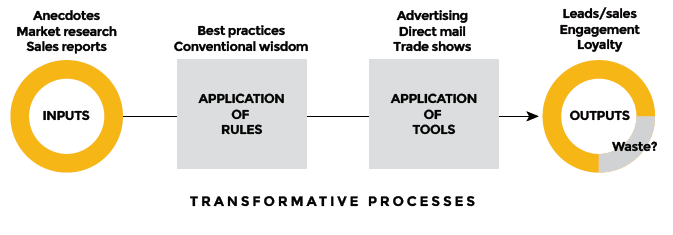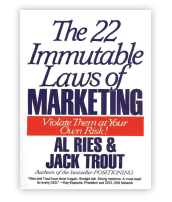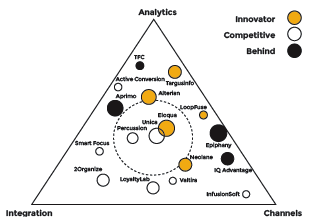The man who knows how will always have a job. The man who knows why will always be his boss.
This observation, attributed to0 Ralph Waldo Emerson, has found new relevance in the field of marketing. In fact, Movéo believes there is a new marketing value chain in which “knowing why” will increasingly be the driver of success. Before we describe this new chain, however, it’s important to take a step back and understand the old one — specifically the value it offered and how it came to be.
Marketing’s unchanging goal: Predictability
For over 50 years, many people suffering from certain autoimmune disorders have benefited from antibody replacement therapy. The precise mechanism by which this therapy works on these conditions has still not been definitively established. The bottom line is that often times it does work, although doctors cannot in any way predict the extent that it will do so in individual cases.
This situation should sound familiar to practitioners of modern marketing. The discipline does work, sometimes even dramatically. But since marketing’s inception at the beginning of the 20th century, marketers have been at a loss to precisely predict its effects with a great degree of accuracy. As a result, a certain amount of waste has been an accepted part of marketing investment. The industry at large has been acutely aware of this problem for a long time (we would insert a familiar John Wannamaker quote here but will spare you this cliché).
Some have sought to address it by making marketing more “scientific.” As far back as 1923, Claude C. Hopkins wrote in his book, Scientific Advertising, “The time has come when advertising has in some hands reached the status of science. It is based on fixed principles and is reasonably exact…Advertising, once a gamble, has thus become, under able direction, one of the safest of business ventures.”
Whether or not marketing has ever achieved the status of a science can be debated. Scientists propose hypotheses as explanations of phenomena they observe and design experiments to test these hypotheses via predictions. The true promise of marketing can only be achieved through better predictability. The extent to which we can foresee the impact of our marketing programs enables inefficiency (and the costs associated with it) to be minimized. It also makes it possible to accurately tie marketing with revenue contribution so that it can finally be looked upon as an investment rather than a cost.
The true promise of marketing can only be achieved through better predictability.
The old marketing value chain
A value chain can be defined as a set of activities that an organization performs in order to deliver a product or service. The concept was first popularized by Michael Porter in his 1985 best-seller, Competitive Advantage: Creating and Sustaining Superior Performance.
While Porter was talking about the activities of an entire organization, his idea can easily be applied to the marketing function alone. Like any system, it is made up of inputs, transformative processes and outputs. How value chain activities are carried out determines costs and affects profits.
For most of its history, marketing has provided its value through practitioners who master a two-link chain consisting of the application of what we call “Rules and Tools.”

Rules and tools
 In 1923 Claude Hopkins argued that there are rules of advertising that, as long as they were understood and followed, would make success both attainable and repeatable (predictable!). In the 1960s, advertising great David Ogilvy sought to codify his success through rules (the first of 10 writing tips he shared in an internal memo sent to all employees of his ad agency in 1982 was to “Read the Roman-Raphaelson book on writing. Read it three times.”). In the 1990s, marketing consultants Al Ries and Jack Trout posited that there were 22 Immutable Laws of Marketing that must be followed to launch or maintain winning brands (“Violate them at your own risk!”). Similar claims are being made today by various players who provide guidance around things like demand generation or multichannel marketing.
In 1923 Claude Hopkins argued that there are rules of advertising that, as long as they were understood and followed, would make success both attainable and repeatable (predictable!). In the 1960s, advertising great David Ogilvy sought to codify his success through rules (the first of 10 writing tips he shared in an internal memo sent to all employees of his ad agency in 1982 was to “Read the Roman-Raphaelson book on writing. Read it three times.”). In the 1990s, marketing consultants Al Ries and Jack Trout posited that there were 22 Immutable Laws of Marketing that must be followed to launch or maintain winning brands (“Violate them at your own risk!”). Similar claims are being made today by various players who provide guidance around things like demand generation or multichannel marketing.
Mastery of marketing tools can also be traced to the beginning of the 20th century. At that time, the state-of-the-art tools were mail order advertising and the effective use of samples. Pioneers such as Lester Wunderman (hailed as the “father of direct marketing”) carved their niche by learning these tools of marketing better than anyone else. Today, many companies take the same approach, focusing on mastery of technology platforms for marketing automation and CRM integration or channels such as social media, for example.

Combining best practices, conventional wisdom and intuition and then applying this knowledge across the latest and greatest tools and channels is how marketing delivered its value. The more you knew about such “rules and tools,” the thinking went, the more predictable your outputs would be.
Old value chain limitations
Employing a “rules and tools” based value chain can help make marketing more effective — especially compared to just “winging it” — but it falls far short of making it more predictable due to two significant limitations:
- Strict adherence to a “rule” does not sufficiently acknowledge that most marketing conditions are NOT constant. Rules that work when certain conditions are present may not work when they are not, or when other conditions arise. In marketing today, many conditions are dynamic and outside the control of marketers (e.g., changing customer behaviors and attitudes, competitive “noise,” etc.).
- A tool-based approach does not sufficiently acknowledge that marketing tools are also dynamic. Even the best marketing analytics software in use today is just the best CURRENT option. Evolving technology can unseat even the most entrenched tools (just ask Blackberry). What’s more, if you have the latest and greatest, there’s always someone selling a similar technology to your competitor. This can neutralize any competitive advantage brought by tools.
The more dynamic the environment, the greater the likelihood of waste occurring in a “rules and tools” based value chain. Because we live in a world that is now in a constant state of flux, this has become a serious problem. While this approach can still lead to successful marketing outcomes, the odds of it doing so have decreased as unpredictability has increased. Unfortunately the demands on marketing practitioners have also increased. CMOs are transitioning away from soft success measures. Expectations of marketing accountability have increased to the levels expected of sales performance. More predictability is required today, not less.
In short, the “Rules and Tools” based value chain is now obsolete. Luckily, it can be replaced with a far more effective one.
More predictability is required today. Not less.
The new marketing value chain
Shifts in technology and customer behavior have produced an almost infinite amount of data — a digital record of every action a customer takes online. It is the accessibility of this data that will allow for a new marketing value chain predicated on insight. Mastery of data will enable companies to predict marketing performance as never before.

Data allows for the value chain to be re-forged into three links:
Data-driven insight, the first link, reveals “why” marketing works. It discerns hidden patterns in the numbers that improve the decision making process in the other two links. Intelligence derived from data can help you find your most profitable customers, identify new business opportunities, deliver better targeted leads to the sales organization, offer realtime insights to make smarter campaign decisions (e.g., running “what if” scenarios, changing creative on the fly, etc.) and much more.
The second link of the chain — strategy — becomes newly enlightened by insight. No longer “flying blind,” companies can move away from an over focus on tactical planning and execution. Smarter decision-making will enable them to greatly minimize, if not eliminate, waste from their programs. Guesswork strategies of old (e.g.,“Say and spray” mass marketing) will be replaced with ones born of confidence and precision — the right offer being made to the right buyer at the right time. This will lead to a quantum leap in marketing performance.
As for the third link, marketers will to continue to apply “rules and tools.” More than ever they will need to identify and capitalize on the best technologies and channels available. They’ll still need to engage customers and inspire employees with powerful brands and creative communications. But data will make these things much more accountable than in the past. It will imbue both creative thinkers and marketing technologists with empirical insight about what works and what doesn’t, rather than them relying on capricious rules of thumb for such guidance.
Reinvention required
As data-driven strategies and delivery take center stage, they will become an important part of competitive differentiation.
Winners will increasingly be the organizations that leverage the new value chain, and this is already happening. A recent study of more than 10,000 marketing executives globally about the use of data found that the respondents who said that their organization highly leveraged data and analytics to improve marketing effectiveness grew significantly faster than those that did not.1 Another study showed that companies that use advanced analytics tools enjoy higher win rates.2 A third study that advanced analytics delivered marketing program efficiency gains of 30% or more.3
Mastery of data-driven insight will increasingly separate the marketing wheat from the chaff, yet putting these skills into practice has not kept pace with aspirations to do so. Marketers, as well as the agencies and consultants they hire, have found they cannot simply flip a switch and become analytically proficient. Analytics reports today are often little more than compilations of data readily available from Google. Multiple data sources — both internal and from other parties — will be needed to provide the type of insight that actually leads to “eureka” moments. Additionally, there will be a need to build sophisticated analytics models for predicting outcomes. This requires hypothesis testing and data mining capabilities that few marketing departments possess today.
The most immediate challenge, then, is to create an organization that can effectively do these things.
Our recommendation?
- Recall Emerson’s quote — stop focusing on the “how” and figure out the “why.” The marketing function must serve as a change agent, leading the charge to employ advanced analytics that will lead to smarter decision-making. Don’t wait for IT to save you.
- Embracing the true power of data will require you to learn how to identify, attract and retain people with the skills and special curiosity to make the valuable discoveries hidden in it. This will necessitate tight alignment with HR, as most of these departments do not have experience tracking down “data scientists.”
- If your organization does not yet have the skills needed, or there are structural constraints that need to be removed before it can apply them, consider partnering with a firm or firms that have made demonstrable progress down this road. The right partner can serve as a bridge while your organization builds its own capabilities, or can remain an integral part of your team over the long term.
The important thing is to actually start taking the concrete steps necessary to turn marketing into the science that Hopkins promised it could be back in 1923. Then, and only then, will the new marketing value chain discussed here deliver real value for your organization.
1 Marketing2020 study sponsored by EffectiveBrands, the Association of National Advertisers, the World Federation of Advertisers, Spencer Stuart, Forbes, MetrixLab and Adobe.
2 CSO Insights
3 Marketing Sherpa
Redefining what an “advertising agency” can be, Movéo uses data-driven insight to help business-to-business and healthcare brands quantifiably improve marketing performance. For more information, visit moveo.com
Download



